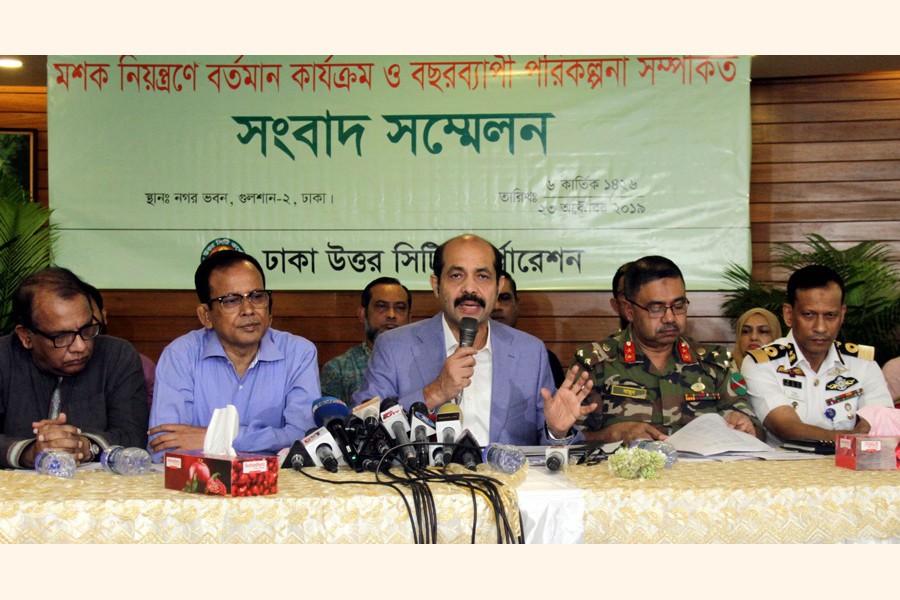
Dhaka North City Corporation area
53pc stagnant drains, 23pc water bodies produce culex mosquito
FE REPORT | Thursday, 24 October 2019

About 53 per cent stagnant open drains and 23 per cent permanent water bodies of the Dhaka North City Corporation (DNCC) area produce culex mosquito, a survey has found.
Other places where mosquitoes are bred include- temporary wetlands 14 per cent, construction sites 8.0 per cent and manholes 2.0 per cent.
According to experts, sewage ponds, drains, ditches, derelict ponds and lakes are the natural breeding grounds of mosquitoes while construction sites, artificial containers, manholes, wetlands and underground water are the modified spots.
They laid emphasis on regular cleaning programme, making the drains flowing, covering all the open breeding grounds like swamps and spraying malaria oil for destroying larvae of culex mosquito.
The experts were speaking at a press meet on the 'Mosquito Control Programme: Present Situation and Yearlong Plan' at DNCC on Wednesday.
DNCC organised the press briefing to share the survey findings on 'Hotspot Surveillance of Culex Mosquitoes in Dhaka North City Corporation'.
Health Department of the DNCC is conducting the 15-day survey from October 07 till today (Thursday).
DNCC Mayor Atiqul Islam said the corporation is working to control culex mosquito as the dengue situation is less prevalent now.
"Our spray men are spraying insecticides in various wards. We will check the quality of the medicine after 30 days," he said.
He further said several wards, including 20, 28, 5, 31, 32, 33 and 17, were identified highly risky during the survey.
As many as 1620 staff members were engaged in the mosquito control programme during the peak time of dengue outbreak, said the mayor while answering questions, adding they will work again after a break of seven days.
Mayor Atiq also said they have a stock of 0.1 million litres of insecticide while a process to import more is underway.
Regarding coordination with the DG health, he said the city corporation is conducting the survey on its own to create a baseline of their own.
DG health conducts survey occasionally and the report will come at a time that may hamper the culex control programme, he added.
DNCC chief health officer Brig Gen Mominur Rahman Mamun said a two-week crush programme started on October 20.
Under the programme, monitoring of the culex hotspot will be conducted.
The survey was conducted in 49 wards out of the total 54.
Five survey teams comprised of two entomologists and 10 apprentices worked in one single ward per day and collected samples from various spots.
Entomologist GM Saifur Rahman presented the key findings of the survey.
He said a total of 635 spots were identified during the survey, of which 215 have very high density of mosquito population, which is 34 per cent.
There was 28 per cent or 175 spots with high, 26 per cent or 167 spots medium, 12 per cent or 67 spots low mosquito density.
Mr Saifur said of the total breeding grounds, there are 41 per cent pacca drains, 23 per cent permanent water bodies, 14 per cent temporary wetlands, 12 per cent kacca drains, 8.0 per cent construction sites and 2.0 per cent manholes.
"Although 23 per cent permanent wetlands seem to less in areas but it has high density of mosquito population," he said.
"We suggest using malaria oil and not larvicide to control culex. Moreover, cleaning drive should be strengthened," said Mr Saifur.
While answering questions on the ongoing drive on corruption of the councilors, Atiqul Islam said the city corporation has served show cause notice on nine councilors for not attending board meeting more than three times.
If they are proved guilty in the court, the city corporation may suspend them on a legal ground, he said.
msshova@gmail.com